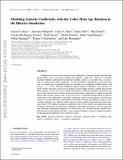Modelling galactic conformity with the colour–halo age relation in the Illustris simulation
Author(s)
Bray, Aaron D.; Pillepich, Annalisa; Sales, Laura V.; Zhu, Emily; Genel, Shy; Rodriguez-Gomez, Vicente; Nelson, Dylan; Springel, Volker; Eisenstein, Daniel J.; Hernquist, Lars; Vogelsberger, Mark; Torrey, Paul A.; ... Show more Show less
DownloadModelling galactic conformity.pdf (10.93Mb)
OPEN_ACCESS_POLICY
Open Access Policy
Creative Commons Attribution-Noncommercial-Share Alike
Terms of use
Metadata
Show full item recordAbstract
Comparisons between observational surveys and galaxy formation models find that dark matter haloes’ mass can largely explain their galaxies’ stellar mass. However, it remains uncertain whether additional environmental variables, known as assembly bias, are necessary to explain other galaxy properties. We use the Illustris simulation to investigate the role of assembly bias in producing galactic conformity by considering 18 000 galaxies with Mstellar > 2 × 10⁹ M⊙. We find a significant signal of galactic conformity: out to distances of about 10 Mpc, the mean red fraction of galaxies around redder galaxies is higher than around bluer galaxies at fixed stellar mass. Dark matter haloes exhibit an analogous conformity signal, in which the fraction of haloes formed at earlier times (old haloes) is higher around old haloes than around younger ones at fixed halo mass. A plausible interpretation of galactic conformity is the combination of the halo conformity signal with the galaxy colour–halo age relation: at fixed stellar mass, particularly towards the low-mass end, Illustris’ galaxy colours correlate with halo age, with the reddest galaxies (often satellites) preferentially found in the oldest haloes. We explain the galactic conformity effect with a simple semi-empirical model, assigning stellar mass via halo mass (abundance matching) and galaxy colour via halo age (age matching). Regarding comparison to observations, we conclude that the adopted selection/isolation criteria, projection effects, and stacking techniques can have a significant impact on the measured amplitude of the conformity signal.
Date issued
2015-10Department
Massachusetts Institute of Technology. Department of Physics; MIT Kavli Institute for Astrophysics and Space ResearchJournal
Monthly Notices of the Royal Astronomical Society
Publisher
Oxford University Press
Citation
Bray, Aaron D.; Pillepich, Annalisa; Sales, Laura V.; Zhu, Emily; Genel, Shy; Rodriguez-Gomez, Vicente; Torrey, Paul et al. “Modelling Galactic Conformity with the Colour–halo Age Relation in the Illustris Simulation.” Monthly Notices of the Royal Astronomical Society 455, no. 1 (November 2015): 185–198.
Version: Author's final manuscript
ISSN
0035-8711
1365-2966